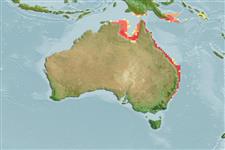>
Syngnathiformes (Pipefishes and seahorses) >
Syngnathidae (Pipefishes and seahorses) > Syngnathinae
Etymology: Hippocampus: Greek, ippos = horse + Greek,kampe = curvature (Ref. 45335); whitei: Name from Latin word for tall, referring to the tall coronet..
More on author: Bleeker.
Environment: milieu / climate zone / depth range / distribution range
Ecologia
marinhas; estuarina demersal; não migratória; intervalo de profundidade 0 - 46 m (Ref. 4281), usually 1 - 25 m (Ref. 30915). Temperate; 20°S - 35°S, 145°E - 160°E
Southwest Pacific: Australia.
Comprimento de primeira maturação / Tamanho / Peso / Idade
Maturity: Lm 8.3, range 8 - ? cm
Max length : 13.0 cm OT macho/indeterminado; (Ref. 30915); 11.0 cm OT (female); common length : 8.0 cm TL macho/indeterminado; (Ref. 4281); idade máx. registrada: 5 anos (Ref. 93066)
Descrição suscinta
Chaves de identificação | Morfologia | Morfometria
Raios dorsais (total) : 17 - 18. This species is distinguished from its congeners by the following set of characters: trunk rings 11; tail rings 34-35; dorsal fin rays 17-18; pectoral fin rays 16; subdorsal rings 3; subdorsal spines 4, superior trunk ridge ending with 3 enlarged spines, the superior tail ridge commencing with one enlarged spine (3/0,1,0); cleithral ring spines 3, one small spine at each end of pectoral-fin base, none at gill-opening, large single or double spine at ventral extent of head; with 2 small lateral head spines, one directly posterior of eye, one anterodorsally of operculum and ventral of coronet; with a distinct snout spine; no parietal spine or diminutive if present; single eye spine, large and protruding dorsally; small single or double spine, rugose, posteroventrally of eye; the coronet, distinct and tall, protruding anteriorly in juveniles, angled
dorsoposteriorly in adults, and with 5 small spines present on apex in a star-like arrangement;
superior trunk with enlarged spines on first and eigth tail ridges (Ref. 125503).
Occur in coastal estuaries and embayments (Ref. 125503); in shallow, weedy inshore areas and Zostera seagrass beds; also on sponges. Also under jetties on holdfasts of kelp, and on other man-made structures such as shark nets. Diurnal and site faithful (Ref. 30915). Female max length (Ref. 42735). Ovoviviparous (Ref. 205). The male carries the eggs in a brood pouch which is found under the tail (Ref. 205). Minimum depth reported taken from Ref. 128812.
Gestation period 21-22 days depending on temperature (Ref. 30915). Monogamous and faithful to pair in the wild (Ref. 30915). Monogamous mating is observed as both obligate and genetic (Ref. 52884). Male carries the eggs in a brood pouch (Ref. 205).
Short, G., D. Harasti and H. Hamilton, 2019. Hippocampus whitei Bleeker, 1855, a senior synonym of the southern Queensland seahorse H. procerus Kuiter, 2001: molecular and morphological evidence (Teleostei, Syngnathidae). ZooKeys 824:109-133. (Ref. 125503)
Status na Lista Vermelha da UICN (Ref. 130435)
Ameaça para os humanos
Harmless
Uso pelos humanos
Pescarias: pouco comercial
Ferramentas
Relatórios especiais
Baixar XML
Fontes da internet
Estimates based on models
Preferred temperature (Ref.
123201): 21.7 - 27.1, mean 25.4 °C (based on 146 cells).
Índice de diversidade filogenética (Ref.
82804): PD
50 = 0.5000 [Uniqueness, from 0.5 = low to 2.0 = high].
Bayesian length-weight: a=0.00447 (0.00177 - 0.01127), b=3.00 (2.78 - 3.22), in cm total length, based on LWR estimates for this (Sub)family-body shape (Ref.
93245).
Nível Trófico (Ref.
69278): 3.4 ±0.5 se; based on size and trophs of closest relatives
Resiliência (Ref.
120179): médio(a), tempo mínimo de duplicação da população 1,4 - 4,4 anos (Assuming annual Fec<1000).
Fishing Vulnerability (Ref.
59153): Low vulnerability (12 of 100).
Nutrients (Ref.
124155): Calcium = 152 [88, 414] mg/100g; Iron = 0.824 [0.417, 1.602] mg/100g; Protein = 17.4 [16.1, 18.8] %; Omega3 = 0.511 [0.228, 1.134] g/100g; Selenium = 17.9 [7.4, 44.4] μg/100g; VitaminA = 8.22 [1.79, 36.79] μg/100g; Zinc = 1.07 [0.68, 1.68] mg/100g (wet weight);
